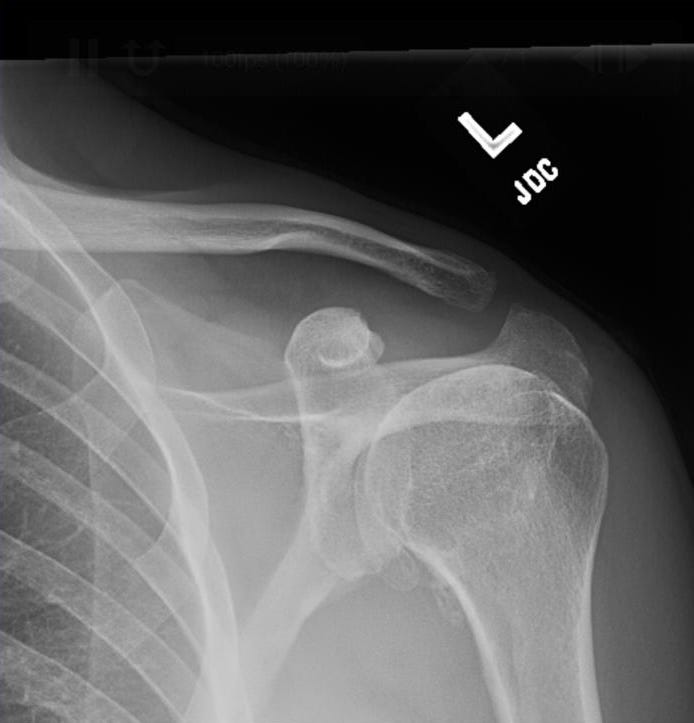I Almost Quit Rock Climbing for Good
What a trip to Ladakh, a wrecked shoulder, and a hard truth from surgeons taught me about self-advocacy and resilience.
In August 2023, I returned from what should’ve been the highlight of my year—three magical weeks of bouldering in the surreal granite playground of Suru Valley, Ladakh. The climbs were hard, the company was world-class, and the stoke was high. But by the time I got back to my parents' guest room in Delhi, I couldn’t even lift my arm without wincing.
(The author on top of a beautiful high ball boulder, framed against a Ladakhi sunset)
I lay in bed, shoulder throbbing, wondering if this was it. The end of climbing as I knew it. Had I pushed too far?
Over the next few weeks, I did the rounds—orthopedists, surgeons, sports med docs. The diagnosis came in like clockwork:
“Stage 4 osteoarthritis.”
“Rotator cuff degeneration.”
“Stop overhead sports or risk a total shoulder replacement.”
(X-Ray of the author’s left shoulder - Supraspinatus tendon tear, severe glenohumeral arthritis)
Each time I heard it, I felt a little more deflated. Climbing has been the one constant in my life—my outlet, my meditation, my way of seeing the world. Giving it up felt like giving up a part of my identity.
But I wasn’t ready to quit.
And I wasn’t foolish enough to ignore the pain.
So I did what any lifelong athlete must learn to do—
I became my own advocate.
I started talking to other athletes in the climbing community. People who had been through injuries, surgeries, burnout, recoveries. I heard stories of those who bounced back by challenging the first (and second) medical opinion. It gave me hope.
I visited multiple physical therapists—not just one. I asked more questions. I learned about modalities I hadn’t explored before: scapular stability, deep rotator cuff activation, functional movement training. Some of it didn’t work. But some of it did.
I slowly began incorporating more rehab into my weekly routine. Not flashy stuff—simple movements done well. I tweaked how I climbed, learned to move with more awareness, avoided certain types of dynamic moves for a while, and focused on fine-tuning technique over raw power.
It wasn’t a straight line.
Some weeks, I doubted myself. Some nights, I iced my shoulder wondering if I was being foolish for pushing at all. But I kept going. I stayed curious. I listened to my body. I respected the pain but didn’t surrender to it.
And then—two years later—I sent my hardest grade in recent memory.
It wasn’t the number, not cutting edge at all. It was about what it represented:
That my shoulder, the one I was told to mothball, still had life in it.
That I still had life in me.
(Video of the author climbing Unabunga, El Salto, Mexico, in March 2025, his hardest climb since the diagnosis)
As my dear friend Ken, in his 50s, and a lifelong gymnast and climber likes to say “If you don’t use it, you’ll lose it.” So I use it - with love.
My injured shoulder still hurts sometimes—and it's often more sore than the other. But I’ve learned to listen to it. To be kind to it. And to trust it again.
Why this story matters
I’ve been doing this work for a few years now—long before I started the podcast. But launching Ageless Athlete last year gave me something more: a deep sense of clarity, fuel, and community.
Every conversation with an athlete who’s defied odds reminded me that healing is rarely linear. That you have to fight—not recklessly, but intelligently—for the life you want to live. That “performance” in our 40s, 50s, 60s isn’t about invincibility—it’s about persistence, curiosity, and self-respect.
So if you’re reading this and dealing with your own version of injury, chronic pain, or just feeling stuck—I hope this lands as a nudge to keep going. Not blindly, but thoughtfully. Ask questions. Be open. Become your own experiment.
You’re not broken. You’re just in the middle of the story.
Warmly,
Kush







Hi Kush! Great article, and nice to find you here on Substack! I too have suffered multiple tendon injuries and a foot surgery over the last few years, and was just able to start training in earnest again a few months back to get back to skiing and dancing. Persistence is key, as is listening to your body. Glad you are still able to do what you love! Maybe we'll cross paths dancing in the bay one of these days!
Best,
Lilliana
Dear Kush,
The recent writing is truly inspiring.
Thank you for writing your experiences and sharing to inspire pothers.
Following statements were truly special:
I became my own advocate.
I started talking to other athletes in the climbing community. People who had been through injuries, surgeries, burnout, recoveries. I heard stories of those who bounced back by challenging the first (and second) medical opinion. It gave me hope.
I slowly began incorporating more rehab into my weekly routine. Not flashy stuff—simple movements done well. I tweaked how I climbed, learned to move with more awareness, avoided certain types of dynamic moves for a while, and focused on fine-tuning technique over raw power.
You’re not broken. You’re just in the middle of the story.
I work with people living with a diagnosis of Cancer. I plan to utilise your approach to create inspirational stories towards mastery of this challenging life experience.
My best wishes for your success in life and your rich contributions. Prof. Murthy